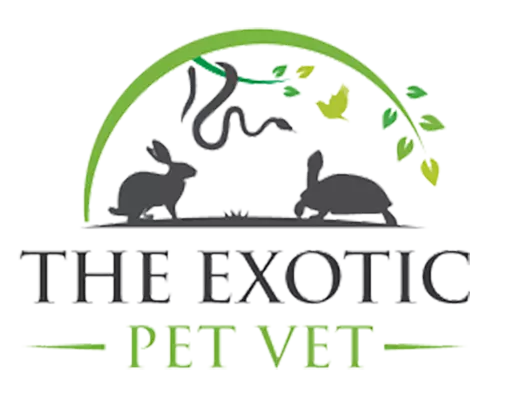Leopard geckos are a popular lizard among amateur pet owners. Leopard geckos are naturally insectivores, consuming only insects like crickets.
This makes them simple to feed and more simple to overfeed. So it’s very important to understand the leopard gecko diet and which bugs are best for them and what are not.
What Does a Leopard Geckos Eat?

Leopard geckos love to eat insects, which is why they will often search for insects in the wild. Crickets and meal worms are the ideal insects to feed your Leopard Gecko. These lizards will eat bugs, spiders, wax worms, silkworms, and scorpions in the wild.
Leopard geckos will also feed on smaller lizards, snakes, and baby rats if they manage to find their territories. Because wax worms and super worms are really high in fat. So, they should only be eaten as a treat. However, overfeeding your gecko may result in obesity.
Leopard geckos will hunt for and pursue their prey rather than patiently awaiting them to stroll by. They will usually hunt by sight, stalking insects carefully and deliberately.
Supplements for Leopard Gecko Diet
You can give your insects the proper amount of vitamin and mineral they need once a week. Leopard geckos mostly require calcium and multivitamin supplements.
Both nutrients are usually found as powders, as a vitamin and calcium powder mix. Besides, vitamins are quite helpful for giving your pet the micro nutrients for giving them a healthy and happy life.
Since leopard geckos are a nocturnal species, be sure to include vitamin D3 to the mixture as well. It is essential for you to supplement their diet with Vitamin D3 since they cannot tan in the sun or under UVB rays.
Leopard geckos need a lot of calcium, and sometimes they can’t get it enough by dusting alone. You can place a tiny tray filled with a pure calcium supplement, in the tank.
What Should You Feed Leopard Gecko?- Healthy Diet
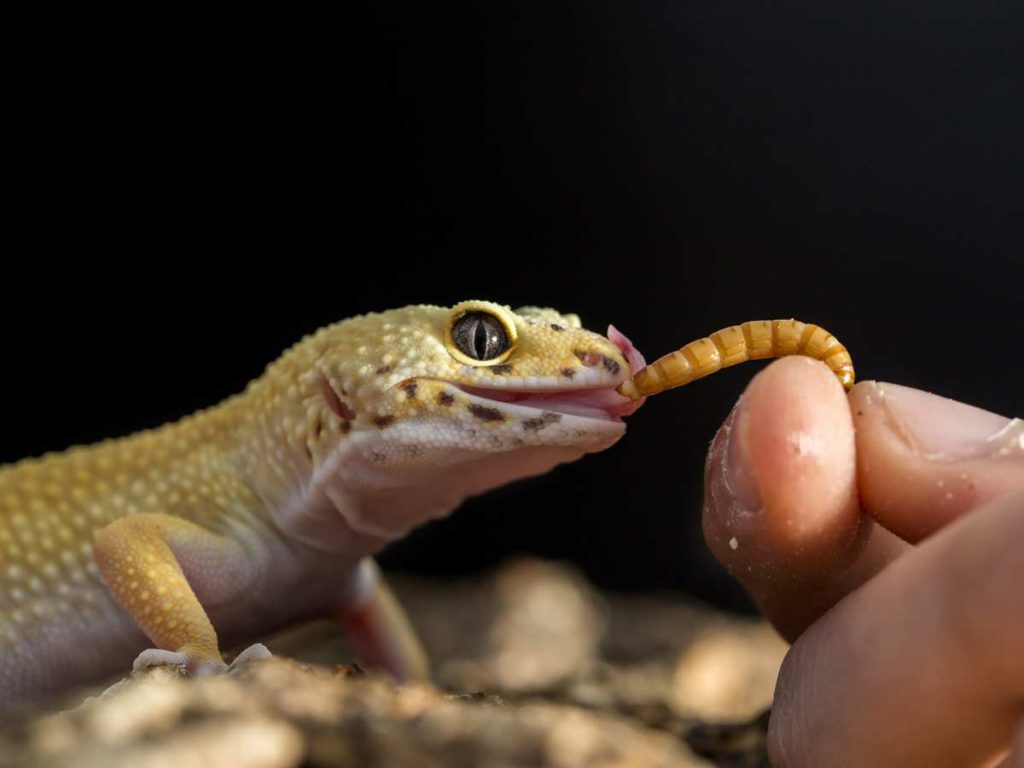
Leopard geckos, despite a few typical pet lizards, will only consume living insects. They will refuse to eat canned or dry reptile food, nor will they accept meat. The most typical leopard gecko feeder insects will be discussed.
1. Crickets
The most popular meal for leopard geckos is house crickets, which are available in large amount at pet stores. Although they are relatively low in fat and have a high protein content, large crickets should always be served with a dusting of vitamin powder for the leopard gecko to eat.
2. Dubia Roaches
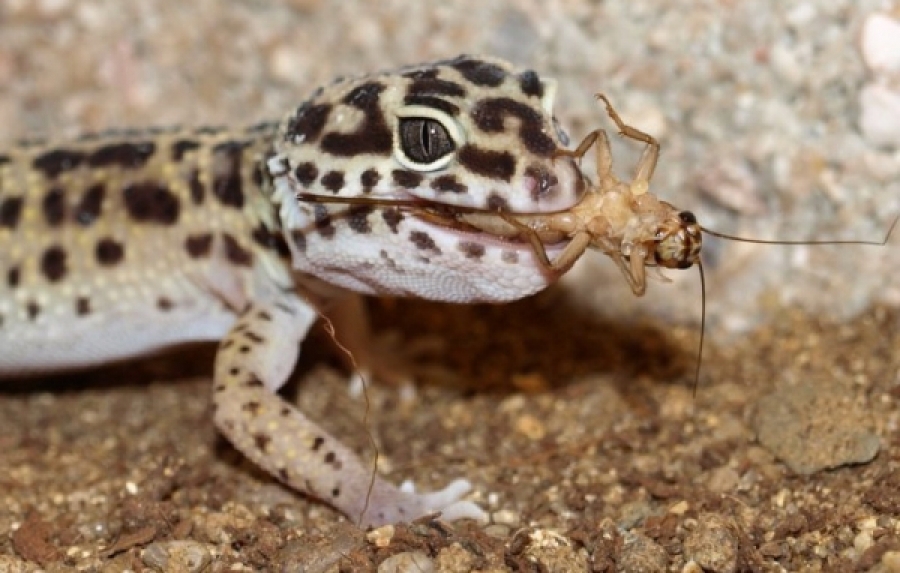
You can feed your gecko , dubia roaches, which are a fantastic staple feeder, a low-fat, easy-to-gut-load, easy to keep, and an outstanding source of calcium for an adult leopard gecko. If you provide an ideal temperature and suitable hiding places, dubia roaches will be simple to produce and have a long lifespan.
3. Mealworms
Leopard geckos enjoy meal worms as food. But since meal worms contain a lot of indigestible chitin, it’s important for you to combine them with other kinds of insects. Adult geckos frequently embrace them since they are simple to maintain and reproduce.
You should always feed meal worms to your gecko before giving them to him or her since they could not have been fed correctly during shipment. When meal worms are prepared to be offered at the pet store, they should be maintained in a cold, dry location.
4. Waxworms
Waxworms should always be given to the geckos as a treat, These worms contains less protein and much fat. So, it can be toxic to leopard gecko diet.
Place the waxworms in the refrigerator, before giving it to your gecko. They might turn into pupae or moths , if not kept in cold.
Foods That Are Toxic To Leopard Geckos

1. Wild Insects
Some sources claim that this may be a good and affordable source of nutritional value, while others advise against giving these insects to your leopard gecko because you can’t tell where they’ve come from or what chemicals they may have been subjected to.
2. Dead Bugs
Dead bugs just don’t provide your gecko with the same vitamins and minerals as living ones, and they won’t pique its inherent desire to hunt. This is true for both freeze-dried insects and dead feeder insect.
3. Firefly and Lightning bugs
The most dangerous insects are those that emit light. These insects ought not to be served as food for geckos since they contain compounds that are very poisonous to them.
Additionally, leopard geckos shouldn’t consume lizard-specific foods. They shouldn’t eat food intended for crested geckos or bearded dragons. Plant products which are not intended for them are present in these meals.
How Often Should You Feed A Leopard Gecko ?
One of the important components of raising leopard geckos is having a good feeding schedule. Young geckos develop quickly. For a healthy growth, they require a lot of minerals, particularly calcium and protein. As a result, kids require feeding more often than adults.
Larger insects must be given to a baby leopard gecko on a daily basis until it is 10 to 12 months old. Once the geckos reach adulthood, their development slows down. They only require one or two feedings every week to be healthy.
Ensure that all of the prey has been gut-loaded with high in vitamins, veggies, and a protein source.
Does Leopard Geckos Eat Fruits and Vegetables?
As insectivores, leopard geckos will eat insects only. Even fruits, vegetables, and other types of meat are indigestible. Because of how their bodies are built.
They lack a functional cecum, an organ responsible for breaking down the material present in fruits and vegetables called cellulose. They have a smaller, weaker skull and jaw than herbivores, which is only for consuming meat.
What Is Gut Loading?
Giving feeder insects nutritious food before feeding time is referred to as “gut loading” so that they are “gut loaded” with the vitamins and calcium your gecko requires.
Because leopard geckos only consume insects, it is necessary to gut-load feeder insects for at least 24 hours before serving.
Leopard geckos require varying amount of insects depending on their age. You can keep your pet leopard happy and healthy by feeding it a suitable number of bugs based on its length, powdered with calcium of course.
Can Leopard Geckos Drink Water?
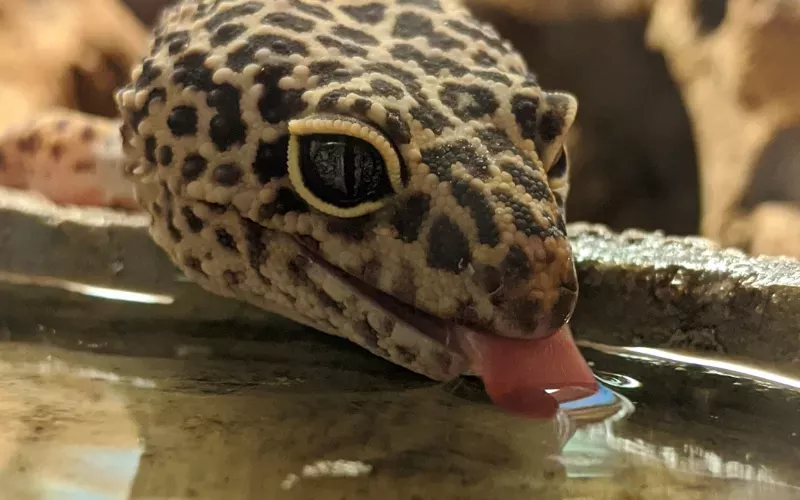
Owners of leopard geckos must understand what their pet lizard needs. Since leopard geckos are native to dessert areas, you might be curious if they need water or not.
Leonard geckos don’t drink frequently but they still need fresh water. For one to two days, leopard geckos may survive without water.
You should always put a bowl of fresh water inside their tank. Giving water once or twice a week would be enough to meet their need. Geckos need water for a variety of reasons, including excretion and digesting.
Leopard geckos can drink tap water. But because not all tap water is of excellent quality, water conditioning them first to remove the chlorine and other dangerous chemicals will be a good idea.
When the water bowl is too deep, the leopard gecko cannot consume it. If the gecko is not put in the water, he will become anxious. He still won’t drink.
Which Feeding Mistakes Are Most Common?
If kept properly, leopard geckos may make wonderful pets and require very little upkeep. However, it’s crucial to be aware of the frequent mistakes that many novice leopard gecko owners might commit.
Overfeeding a pet leopard gecko without comprehending the possible harm it might do is a mistake that many people who own pets do.
Despite being naturally big and storing fat in their tail, this species may still put on weight. So, maintain a feeding plan for your pet and keep an eye out for indications of overeating.
It’s also crucial to take calcium supplements for a gecko to be healthy. Intestinal issues and metabolic bone diseases are brought on by calcium deficiency. UVB sunlight is also necessary for leopard geckos to convert calcium into vitamin D3.
Reasons Why Your Leopard Geckos Not Eating

As previously mentioned, the majority of conditions that might cause lack of appetite are common, minor issues that will go away on their own.
There will occasionally be a need for a trip to the veterinarian, but there are typically common sense things you can do on your own to ease the problem.
1. Cold Tank
One of the common reason why geckos are not eating as much – is probably the temperature. If the tank is too cold, they might refuse to eat and become inactive. Geckos’ metabolism speeds faster in warm weather. They react more quickly because of their good metabolism, which improves their ability to seek prey.
The floor temperature should always be 85 degrees Fahrenheit. With the help of a temperature gun, you can easily check the temperatures on the tank’s two sides.
2. Brumation
Brumation, a kind of reptile hibernation, may result from organic or induced factors. It is a normal phase that last between a few weeks or several months. A gecko will become lively again after a week.
There is a good chance that a gecko that is totally healthy if it stops eating in late fall or early winter. They might also spends a lot of time hiding. Females will brumate before mating because they require more energy to produce eggs.
3. Shedding Season
A leopard gecko adult will typically lose its skin every four to eight weeks. They use this treatment to replace worn-out skin with new skin. The skin begins to shed approximately a week before it is completely gone.
You shouldn’t be concerned if an animal stops eating for a day or two because this is very normal behavior for such animals throughout the shedding process. When your leopard gecko refuses to eat, even after it has shed, there may be a more severe issue at hand.
4. Breeding
An egg-bearing or ovulating female gecko would often have less of an appetite while she makes a nest and gets ready to mate. Even in the absence of a male, they can ovulate. During this time, some ladies will stop eating.
The whole month of February until the end of November is when Leos reproduce. Unless it gets extreme, this is natural behavior and shouldn’t be a reason for concern.
How To Get Geckos To Eat?
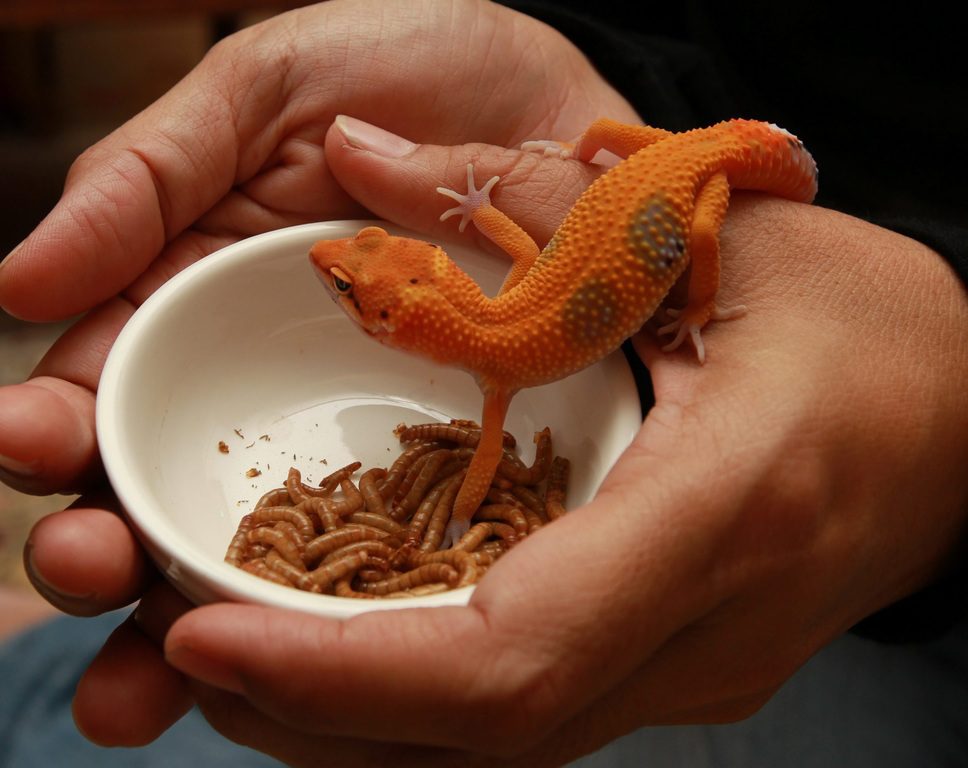
It is important to ensure that the temperatures within the enclosure are at the proper levels. Inspect all thermometers no less than once a day. Along with that make sure your that the heat mats or bulbs are working properly.
Some leopard geckos may be picky eaters. So changing their diet to include various feeder insects may make them more open to their food. Gut load or powder the insects to ensure your gecko is getting the right nutrients.
You should reconsider placing a gecko among other animals since the setup can frighten it. If your gecko is rapidly losing weight, you should consult a veterinarian.
These reptiles are very sensitive to changes, hunger loss is frequently a key contributing factor. So, if the enclosure is relocated, changed, or its substrate and chemicals are constantly changed, your leopard gecko may become upset.
Conclusion
Healthy geckos are easy to care as they would devour whatever bug they come across in the wild. Your gecko will remain happy and healthy if you provide it a variety of food, such as crickets and Dubia roaches.
You can make sure your lizard receives all of the nutrients it needs by giving it calcium and multivitamin powder, as well as gut-loading insects, before eating it.
FAQs
Can I feed my leopard gecko anything other than insects?
Since leopard geckos are insectivorous, they are prior to feeding insects. Their bodies is not designed to digest anything else. Therefore, leopard geckos should not eat fruits or vegetables.
Do leopard geckos need to eat everyday?
Yes, leopard geckos under a year old require daily feeding. Adult geckos can be fed two to three times each week, while young geckos can be fed on a daily basis.
Do Gecko’s Have Teeth?
The average gecko has between 50 and 100 teeth. There are more than 2000 distinct kinds of geckos in the world today, and they are all carnivorous.
What is the best thing to feed a Leopard Gecko?
Leopard gecko’s mostly eat live insects for food. Commercially bred crickets together with lesser quantities of silkworms, roaches, superworms, and other live insects may make up a suitable diet.
What is leopard geckos natural habitant?
Leopard geckos are nearly typically found on boulders because they prefer a rocky substrate than a sandy one.
